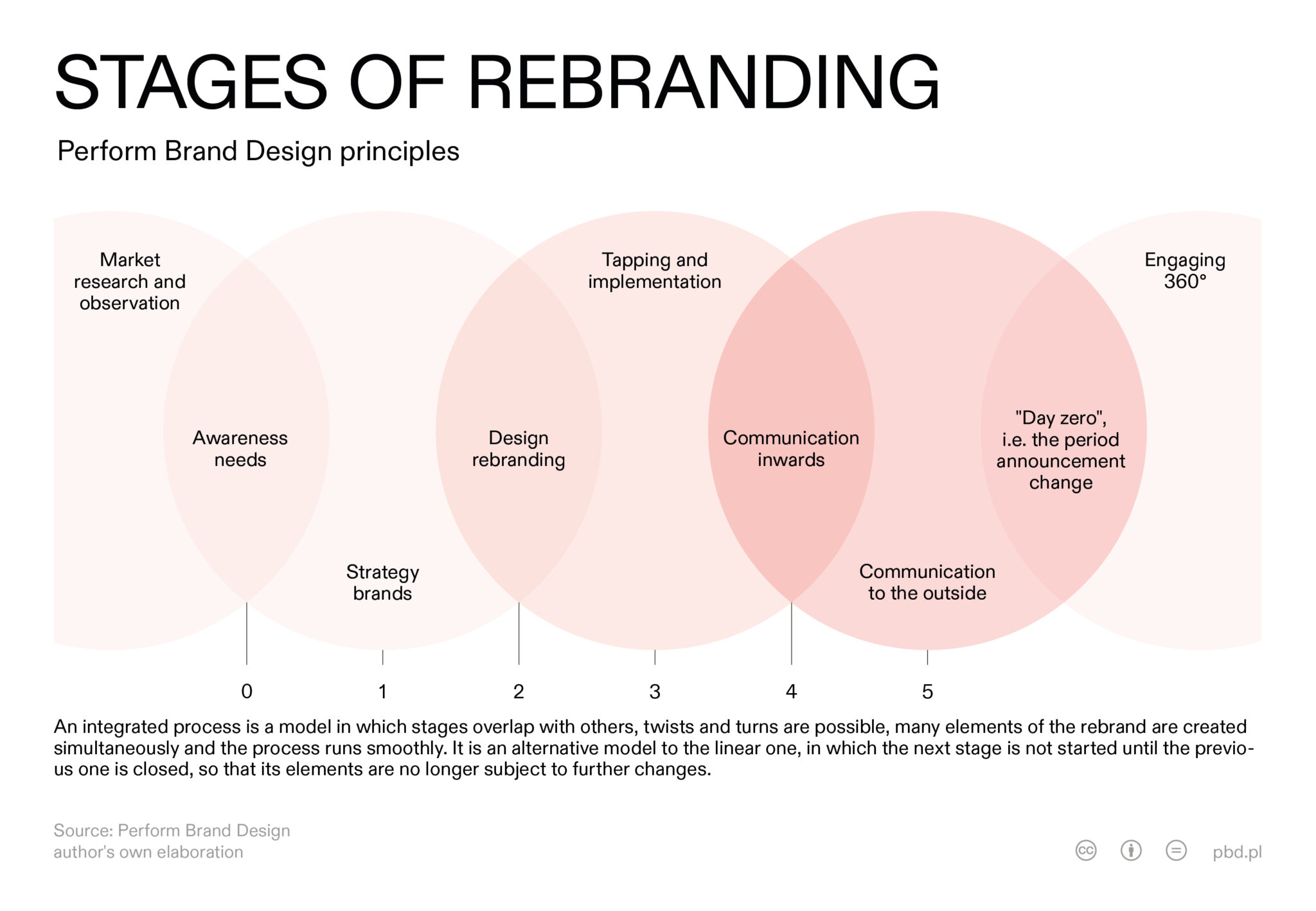
If your brand isn’t connecting with your audience, sales are lagging, or your identity feels outdated, it might be time for a rebrand. Whether you’re launching a new product or refining an established brand, creating a strong and recognizable identity takes effort. Logos, websites, style guides, and messaging all play a role — but over time, businesses evolve, and so should their branding.
A successful rebranding strategy helps you adapt without losing what makes your brand unique. But should you make a few small adjustments or take a bold new direction? Let’s break down when rebranding makes sense, when it doesn’t, and how to do it right — plus, stick around for some great real-world examples.
What Does Rebranding Mean?
Out with the old, in with the new! Rebranding is more than just creating a new logo and updating your website.
If your mission statement is outdated, your brand values have changed, and you’re struggling with sales, then it’s better if you start listing ideas for what you want to accomplish with your rebranding, while keeping your ideal customer in mind, and thinking about the things you would like to change.
When Is a Good Time for a Rebranding?
As your business evolves, you want to evolve and change with it. It’s common for businesses to create a new identity as a strategic way to elevate their struggling or outdated brand. Executing a well-thought-out rebranding strategy can yield stellar results and boost sales for your business. Conversely, a rushed or poorly financed rebranding strategy will most likely come off as sloppy and meaningless, and will certainly not resonate with customers.
When you look like everybody else
You notice that over time all your competition has developed the same look and feel, a similar font, the same house style, and almost the exact same brand colors. Perhaps rebranding would be a nice way to differentiate yourself from the competition? Whether this is a good idea depends on your position in the market. Are you a market leader, i.e. a long-standing, recognizable brand? Or are you an underdog with a fresh new take on the market?
Rebranding will always impact your existing audience. A different look or name will be met with some resistance and your brand recognition will drop momentarily. But if you are a challenger brand and want your new branding to represent the innovative approach you bring to the table, rebranding might do you good.
When you’re breaking into new audiences and markets
You are trying to engage millennials with your dog biscuit company and you’re conquering the UK market. Your branding, however, is not performing well among your latest target territories. There’s a reason why the same toothpaste is called Pepsodent in the Nordics and Prodent in Benelux. Different branding styles work for different markets and audiences.
If you are serious about the potential that your new audience has and you’re confident that changing your branding will make a positive impact, go for it.
When your brand has expanded
You’ve introduced some prominent new products or services to your portfolio which are performing great. You are getting new customers, new interest, and are considering changing your branding to reflect your new offering.
For example, if in the past your main business was legal advice to mid-sized companies and now half of your business comes from offering financial and strategic consulting to start-ups, maybe your logo should no longer be the same — this may very well appear as misleading to your new customer segment.
When your brand is outdated
If you’ve had the same branding for 20 years, and it still screams early 2000s in the same way that glittery blue eye shadow, Blink-182, and Game Boy Advance do, maybe it’s time to breathe new life into it. Take the time to think about what type of brand look you’d like to achieve.
When you’ve merged or been acquired
This one’s an easy decision. If two companies join forces, that most likely means some changes to strategy, product, and service focus, target markets or segments. And all those changes are solid triggers for rebranding.
Wrong Reasons to Rebrand
Just for the sake of it
If you’re tired of your brand’s look and feel, and you’re unmotivated to create content or marketing collateral, that’s not a good reason to rebrand. If you rebrand needlessly, you may confuse your customers and alienate them. This is the last thing you want. You are better off working on a new marketing strategy than a rebranding strategy.
PR crisis
You’ve had a few high-profile press blunders and feel like the whole world is mad at you. Influencers are calling you canceled and telling everyone to avoid your products and services. It can feel enticing to rebrand your whole show to start with a clean slate. No more past mistakes, nice new name and look … But it’s not a good idea.
People will find out and lose their remaining respect for your brand. The best way to deal with a crisis is to listen to feedback, make changes internally to avoid making the same mistakes in the future and apologize for what you did wrong.
Internal debates
New management, shareholders or high-level leaders come in and they want to make their mark on the company. Preferably something concrete and visible to show everyone the company is shifting gears. How about modernizing the look of the brand?
Maybe, maybe not. If the new investment or personnel change is part of a wider organizational restructure where the strategy adapts, mission evolves, and overall direction of the brand changes, fair enough. The brand style needs to reflect that. But if the changes are more like tweaks, don’t change the branding. It will confuse your audience and you’ll risk losing brand recognition and awareness.
Aligning Your Rebranding Strategy With Brand Guidelines
A rebrand isn’t just about swapping out your logo or picking a new color palette. It ensures that every aspect of your brand feels cohesive and intentional. Without brand guidelines, your rebrand can quickly become a confusing mix of mismatched visuals and inconsistent messaging.
Brand guidelines serve as the foundation for your rebranding strategy, helping internal teams, external partners, and stakeholders maintain consistency across every customer touchpoint.
Whether you’re making subtle refinements or rolling out a complete brand overhaul, updating and enforcing brand guidelines should be a top priority.
What to Update in Your Brand Guidelines
Your rebrand needs to be more than just a fresh coat of paint. It should reflect the evolution of your business, audience, and values. As you refine your brand identity, make sure to update:
-
Visual Identity: Logos, typography, color schemes, and imagery must be aligned across all platforms. If your old branding relied on muted tones but your new identity embraces bold, vibrant colors, your brand guidelines should clearly define how and where to use them.
-
Messaging and Tone: Your brand’s voice should feel consistent across marketing materials, social media, and customer interactions. If you’re shifting from a corporate tone to a more conversational one, outline clear guidelines on word choice, phrasing, and preferred communication styles.
-
Brand Applications: Everything from email templates to social media graphics to packaging should follow a unified look and feel. Define rules for logo placement, font usage, and layout structures to avoid inconsistencies.
-
Content Guidelines: If you’re repositioning your brand to appeal to a different audience, your content should reflect that shift. Whether it’s blog posts, video scripts, or ad copy, make sure your messaging speaks directly to your updated audience.
Maintaining Brand Consistency Post-Rebrand
A successful rebrand sustains consistency long after the rollout. Consider these steps to keep your brand on track:
-
Train Your Team: Educate employees, designers, and marketing teams on your updated brand guidelines. The more they understand the “why” behind the rebrand, the better they’ll implement it.
-
Use a Centralized Asset Library: Store logos, templates, and marketing materials in an easily accessible digital asset management (DAM) system to ensure everyone is using the correct versions.
-
Audit Your Brand Regularly: Periodically review marketing materials and customer touchpoints to ensure everything aligns with your new identity. A brand that evolves without guidelines can quickly lose its clarity.
A well-executed rebrand is only as strong as the guidelines that support it. Without a structured framework in place, even the most well-designed rebrand can fall apart. Set your brand up for long-term success by ensuring every detail is intentional, aligned, and consistently applied across your entire organization.
Get Started on Your Rebranding Strategy
If your content and message feel stale, consider a fresh approach. You don’t have to change everything about your brand; you may just need to breathe new life into some aspects of your business. First conceptualize, and then visualize what you want to accomplish with your rebranding strategy, keeping your ideal customers in mind throughout the process.
Consider the following:
-
Do you want to implement a few changes, or do you need a complete brand overhaul?
-
Has your target audience changed or evolved?
-
If your brand isn’t in alignment, you may want to focus on updating your vision, mission statement, and values.
-
How can a new style guide and identity help you accomplish your brand’s goals?
-
Are you ready to make a strong statement?
Focus on a long-term plan, so you’re not changing logos every year. That creates confusion for customers. Map out a rollout strategy for your new, fresh look and create new marketing materials to let people know what’s new. It is impossible to build a strong brand in a day. Strive to create a strong brand identity that’s recognizable and consistent.
5 Examples of Rebranding Done Right
1. Old Spice
When it comes to deodorant, customers have so many options. Old Spice worked with NFL Player Isaiah Mustafa and created a series of commercials that showed Old Spice in a new light.
Instead of dull and boring, Old Spice sent a message that the brand was fresh and relevant. The commercials were a hit, and people started to take notice of the antiperspirant again.
Takeaway: Create brand consistency to improve brand awareness.
2. Coty
Beauty company Coty got a complete brand overhaul, and the new joyful and colorful identity worked. The visual identity was based on an iconic symbol of change, beauty, and diversity: the butterfly. It gave new life to the brand, which previously had minimal engagement and a lackluster customer experience.
Takeaway: Sometimes, a new look goes a long way. Go big, or go home!
3. Dunkin’
Say the word “Dunkin’,”and you automatically think about donuts. Although that’s a symbol of strong brand awareness, the brand decided to drop the word “donuts” in a rebrand to modernize customers’ experience. They changed the look of their stores, got a new logo, and freshened up their brand messaging.
Takeaway: If you’re going to change your name, make sure it still resonates with your audience. Be consistent with your branding in everything you do.
4. Burberry
Luxury brand Burberry is a powerhouse in the fashion industry. Its iconic trench coats and distinct tartan plaid is recognized around the world. Over time, Burberry rebranded to create a new image without abandoning their roots.
Takeaway: Strive to keep your authenticity, even when you want to modernize your look.
5. Energizer
A new logo and new packaging gave Energizer a lighter look and a chance to stand out against competitors. When you think of most batteries, they’re all black with an accent color. Energizer focused on its highly recognizable pink bunny mascot and put a new spin on their rebranding package.
Takeaway: Don’t be afraid to make a bold move to switch things up and stand out. If something is working, like a mascot that everyone knows, don’t stray too far from that image.
Make Your Rebranding Strategy Work for You Today With Lytho
Rebranding is a strategic decision that requires thoughtful planning and execution. By aligning your strategy with clear brand guidelines and maintaining consistency throughout the process, your business can successfully transition to a refreshed identity. Remember, a rebrand is about resonating with your audience and staying true to your evolving values.
Ready to streamline your rebranding efforts? Discover how Lytho’s creative operations tools can help your team collaborate effectively and maintain brand consistency throughout your rebrand. Schedule a demo today to see how our solutions can support your creative process!
Do you want to give yourself and your creative team more room for creative stimulation by automating the boring stuff? Lytho helps you streamline your entire workflow and harmonize all brand collateral under a single, uniform platform. Feel free to reach out to us by scheduling a demo and learning how our creative solutions can boost the effectiveness of your creative projects. We look forward to speaking with you!

Ready to simplify your creative operations and start having a little fun at work again? Schedule time to talk with us.
Let us show you how Lytho’s Creative Operations Platform helps in-house creative and marketing teams do better work, ease the stakeholder experience, and stay on brand.
Schedule a Demo

